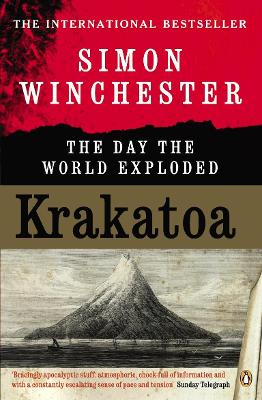Windsor Selection S.
2 total works
Simon Winchester's brilliant chronicle of the destruction of the Indonesian island of Krakatoa in 1883 charts the birth of our modern world. He tells the story of the unrecognized genius who beat Darwin to the discovery of evolution; of Samuel Morse, his code and how rubber allowed the world to talk; of Alfred Wegener, the crack-pot German explorer and father of geology. In breathtaking detail he describes how one island and its inhabitants were blasted out of existence and how colonial society was turned upside-down in a cataclysm whose echoes are still felt to this day.
In the summer of 1815 an extraordinary hand-painted map was published in London. Some eight feet tall and six feet wide, brightly coloured - in sea-blue, green, bright yellow, orange, umber - it presented England and Wales in a beguiling and unfamiliar mixture of lines and patches and stippled shapes. It was the product of one man's obsession with rocks, a passion that sustained him whilst the rest of his life slid into ruin. For nearly 20 years, an Oxfordshire blacksmith's son named William Smith journeyed across Britain investigating and naming the layers of rock beneath his feet. Self-taught and determined, Smith had great expertise in practical geology, and this evolving science demanded a new sort of delineation. The beautifully executed map he produced was the first of its kind and transformed the way in which the world was understood. It was a document that laid the groundwork for the making of great fortunes in oil, iron and tin, and, elsewhere, in diamonds, platinum and silver, and was key to the development of one of the great fields of modern science.
Smith's was a remarkable achievement, and all the more astonishing for having been completed single-handedly and without financial or professional support. Shatteringly, such heroic and painstaking work exacted a terrible price: imprisoned for debt, Smith was turned out of his home; his work was plagiarized; the scientific establishment turned its back on his trouble; and Smith's wife was diagnozed insane and he himself fell ill. It was not until 1829 that, in a fairy-tale twist of fate, Smith returned to London in triumph, to be hailed as a genius. Simon Winchester, best-selling author of "The Surgeon of Crowthorne" and himself the holder of a degree in geology, enters the dramatic world of "Strata Smith" to tell his moving and inspiring story. Celebrating the unique geology of the British Isles, "The Map That Changed the World" resurrects the forgotten pioneer whose passion for fossils came above all else.
Smith's was a remarkable achievement, and all the more astonishing for having been completed single-handedly and without financial or professional support. Shatteringly, such heroic and painstaking work exacted a terrible price: imprisoned for debt, Smith was turned out of his home; his work was plagiarized; the scientific establishment turned its back on his trouble; and Smith's wife was diagnozed insane and he himself fell ill. It was not until 1829 that, in a fairy-tale twist of fate, Smith returned to London in triumph, to be hailed as a genius. Simon Winchester, best-selling author of "The Surgeon of Crowthorne" and himself the holder of a degree in geology, enters the dramatic world of "Strata Smith" to tell his moving and inspiring story. Celebrating the unique geology of the British Isles, "The Map That Changed the World" resurrects the forgotten pioneer whose passion for fossils came above all else.

